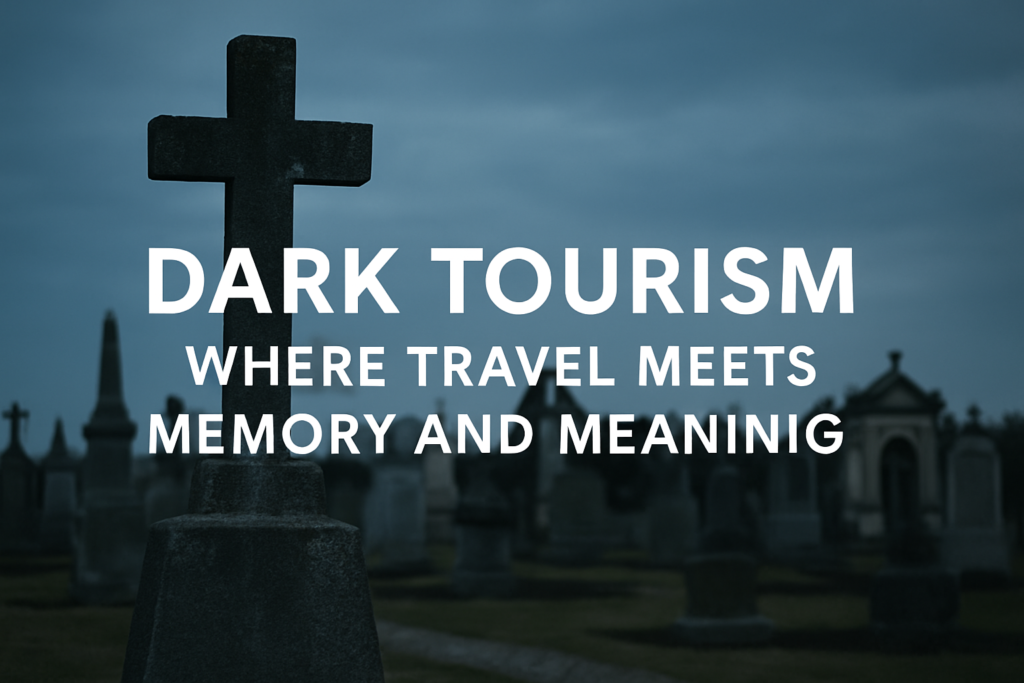🖤 What is ‘Dark Tourism’?
Let’s start with the basics.
Dark tourism, also known as grief tourism or thanatourism, is about visiting places linked with death, tragedy, and historical pain. It’s not about thrill-seeking—it’s about connecting with the past, reflecting on human experiences, and sometimes facing the uncomfortable truths we usually avoid. (source).
🕵️ Are You a Dark Tourist?
Ask yourself this: Have you ever visited a war museum? Felt a lump in your throat at Jallianwala Bagh? Been curious about the mystique of Bhangarh Fort? Thought of visiting the Hiroshima Peace Memorial in Japan or the 9/11 Memorial in New York?
If your answer is yes—or even maybe—then you’ve likely stepped into the world of dark tourism, whether you realised it or not. And that’s totally normal. In fact, millions of people visit such places every year. There’s clearly a deeper human connection here—something that goes beyond sightseeing.
Sometimes, places we visit aren’t just scenic—they’re emotionally intense. If you enjoy traveling with a bit of depth and soul, you might love my blog on travel as escapism. Read it here
Dark Tourism in India: A Journey Through Silent Stories
When we talk about travel, we often think of beaches, mountains, or heritage sites. But there’s another side—dark tourism in India, also called dark travel in India. This is about visiting places linked to death, mystery, tragedy, or history that’s not always easy to talk about. These places aren’t just spooky or haunted—they tell real stories—some heartbreaking, some unexplained, but all worth knowing.
Here are a few lesser-known spots that carry those quiet stories:
🏔️ Roopkund, Uttarakhand – The Skeleton Lake
Hidden in the Himalayas, this lake is filled with human skeletons. No one knows exactly what happened, but theories range from ancient rituals to sudden hailstorms. It’s eerie, intriguing, and pure mystery.
🖤 Dumas Beach, Gujarat – Where the Dead Whisper
Locals say it’s haunted. Scientifically, maybe not. But one moonlit walk on this black sand beach, and even the biggest skeptics go silent.
🏝️ Ross Island, Andamans – Beauty with a Brutal Past
Once the “Paris of the East” during British rule, now it’s a haunting ruin of colonial cruelty. The silence here speaks louder than any guide ever could.
🏚️ Kuldhara Village, Rajasthan – The Deserted Village
An entire village abandoned overnight? Locals say it’s cursed. Tourists say it’s cool. Either way, it leaves you thinking.
🐦 Jatinga, Assam – The Bird Suicide Mystery
Every year, birds drop dead from the sky. No one knows why. Natural phenomenon or supernatural? You decide.
🌍 Dark Tourism Spots Around the World
- Auschwitz-Birkenau, Poland
- Chernobyl, Ukraine
- Hiroshima Peace Memorial, Japan
- 9/11 Memorial, USA
- Tuol Sleng Genocide Museum, Cambodia
- Berlin Wall remnants, Germany
- Pompeii, Italy
- Catacombs of Paris, France
- Alcatraz Island, USA
- Killing Fields, Cambodia
- Ground Zero, New York
- Robben Island, South Africa
💔 How Grief Tourism Shapes Local Communities
Some communities benefit from tourism money, which helps preserve memory and educate visitors. But others feel retraumatized by the constant retelling of their pain.
The key? Awareness and respect.
🤔 Is Dark Tourism Good or Bad?
Here’s the big question: Is it okay to “visit” a place of suffering?
Honestly, it depends on how you approach it.
Dark tourism isn’t about thrill-seeking at someone else’s expense. It’s about remembrance, empathy, learning from the past, and reflecting on the human condition. But yes, there’s a fine line between respectful curiosity and insensitive content-making.
🧠 Why Are We Drawn to Places of Tragedy?
Let’s be honest—none of us go looking for sadness. But there’s something about visiting these sites that taps into our human need for understanding, empathy, and reflection.
Maybe we want to connect with the stories we’ve only heard in textbooks. Maybe we want to pay our respects. Or maybe, we’re just trying to make sense of the world’s chaos in our own small way.
It’s not morbid curiosity—it’s emotional curiosity.
⚖️ The Fine Line Between Remembrance and Exploitation
This part can get a little complicated.
When done with the right mindset, dark tourism helps keep history alive, honours the people who suffered, and teaches important lessons.
But if it’s just for clicks, reels, or drama—it starts to feel wrong. That’s when it crosses a line.
So ask yourself:
Are you visiting to understand—or just to post about it?
🙏 How to Be a Responsible Dark Tourist
- Learn before you go – Know the stories and significance.
- Respect local emotions – You’re walking on someone’s history.
- Support local efforts – Museums, guides, memorial funds.
- Be aware of your presence – Sometimes, your silence can speak volumes.
🎯 Final Thoughts: So… Should Tragedy Be a Tourist Spot?
Maybe we shouldn’t call them “tourist spots” at all. These are not destinations you tick off. They’re places you carry with you—quietly, respectfully.
Because sometimes, the most powerful stories are the ones that break your heart a little.
💬 Your Turn…
Ever visited a place that made you feel something beyond words? One of those where you came back a little quieter, a little more thoughtful?
Tell me. DM, comment, or just sit with it for a bit.
Not every journey is about adventure—some are about awareness.


I like the efforts you have put in this, regards for all the great content.
Great information shared.. really enjoyed reading this post thank you author for sharing this post .. appreciated